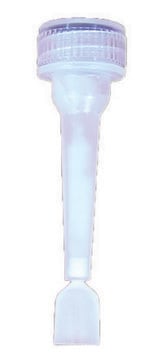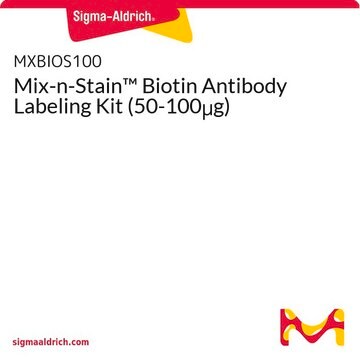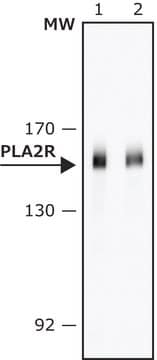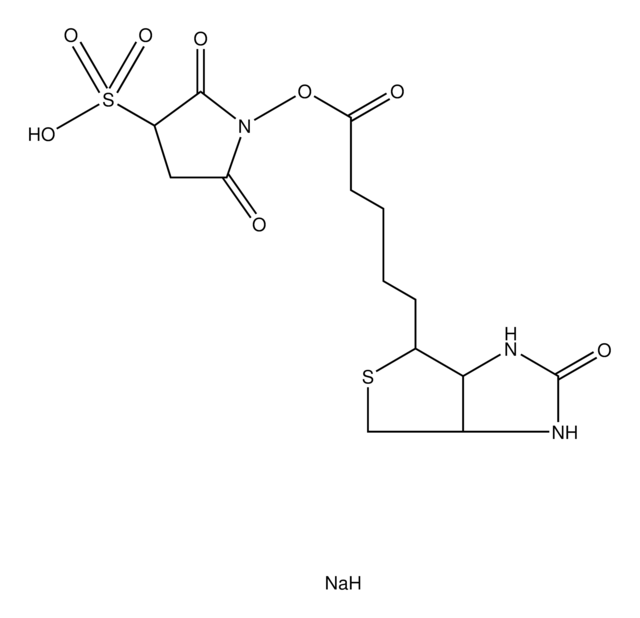11418165001
Roche
Biotin Protein Labeling Kit
sufficient for 5 labeling reactions, kit of 1 (5 components), suitable for immunoblotting, suitable for ELISA
Synonym(s):
Biotin, protein labeling
Sign Into View Organizational & Contract Pricing
All Photos(1)
About This Item
UNSPSC Code:
12352200
Recommended Products
usage
sufficient for 5 labeling reactions
Quality Level
packaging
kit of 1 (5 components)
manufacturer/tradename
Roche
technique(s)
ELISA: suitable
immunoblotting: suitable
storage temp.
2-8°C
General description
For labeling of proteins with biotin.
Free amino acids of the protein to be labeled react with D-biotinoyl-ε-aminocaproic acid-N-hydroxy-succinimide ester (biotin-7-NHS) by forming a stable amino bond. Non reacted biotin-7-NHS is separated on a Sephadex G-25 column.
Free amino acids of the protein to be labeled react with D-biotinoyl-ε-aminocaproic acid-N-hydroxy-succinimide ester (biotin-7-NHS) by forming a stable amino bond. Non reacted biotin-7-NHS is separated on a Sephadex G-25 column.
Application
Biotin protein labeling kit has been used to produce biotinylated denatured bovine serum albumin (d-BSA) for coating cadmium telluride (CdTe) quantum dot (QD) conjugates.
The kit is suitable for the labeling of proteins with biotin for immunochemistry, immunoblotting, and ELISA.
The kit is suitable for the labeling of proteins with biotin for immunochemistry, immunoblotting, and ELISA.
Packaging
1 kit containing 5 components.
Quality
Function tested.
Preparation Note
Working solution: Preparation of the solutions
- Blocking solution: Dissolve the contents of the bottle blocking reagent (green screw cap) in 300 ml double-distilled water.
- PBS solution: Dissolve the contents of the bottle PBS (blue screw cap) in 1 I double-distilled water.
- Biotin-7-NHS solution: The solution should be freshly prepared before labeling. Add to the contents of the reaction vial which includes biotin-7-NHS 250 μI DMSO and vortex the solution several times. The resulting concentration of the biotin-7-NHS solution is 20 mg/ml. For the labeling mix, the volume of the biotin-7-NHS solution should not exceed 5% of the total reaction volume (e.g., add maximal 50 μl biotin-7-NHS solution to 1 ml protein solution).
Other Notes
For life science research only. Not for use in diagnostic procedures.
Kit Components Only
Product No.
Description
- Blocking Reagent (green screw cap)
- Phosphate Buffered Saline (PBS) (blue screw cap)
- D-Biotinoyl-ε-aminocaproic acid-N-hydroxysuccinimide ester (Biotin-7-NHS)
- Dimethylsulfoxide (DMSO) (red screw cap)
- Sephadex G-25 Columns
Storage Class Code
11 - Combustible Solids
WGK
WGK 1
Certificates of Analysis (COA)
Search for Certificates of Analysis (COA) by entering the products Lot/Batch Number. Lot and Batch Numbers can be found on a product’s label following the words ‘Lot’ or ‘Batch’.
Already Own This Product?
Find documentation for the products that you have recently purchased in the Document Library.
Customers Also Viewed
Oladapo O Yeku et al.
Frontiers in immunology, 12, 663379-663379 (2021-05-04)
Immunotherapy for ovarian cancer is an area of intense investigation since the majority of women with relapsed disease develop resistance to conventional cytotoxic therapy. The paucity of safe and validated target antigens has limited the development of clinically relevant antibody-based
Peter Bults et al.
Journal of chromatography. B, Analytical technologies in the biomedical and life sciences, 1144, 122079-122079 (2020-04-05)
The quantitative determination of intact proteins in biological samples by LC with high-resolution MS detection can be a useful alternative to ligand-binding assays or LC-MS-based quantification of a surrogate peptide after protein digestion. The 22-kDa biopharmaceutical protein somatropin (recombinant human
Simultaneous and sensitive determination of multiplex chemical residues based on multicolor quantum dot probes.
Peng C, et al.
Biosensors And Bioelectronics, 24(12), 3657-3662 (2009)
Xingwang Zhao et al.
Science advances, 5(7), eaaw0315-eaaw0315 (2019-07-23)
B cell activation is regulated by the stimulatory or inhibitory co-receptors of B cell receptors (BCRs). Here, we investigated the signaling mechanism of Fc receptor-like 1 (FcRL1), a newly identified BCR co-receptor. FcRL1 was passively recruited into B cell immunological
Xing Wei et al.
Stem cells (Dayton, Ohio), 27(2), 478-488 (2008-11-22)
Adipose tissue stroma contains a population of mesenchymal stem cells, which support repair when administered to damaged tissues, in large part through secreted trophic factors. We directly tested the ability of media collected from cultured adipose-derived stem cells (ASCs) to
Our team of scientists has experience in all areas of research including Life Science, Material Science, Chemical Synthesis, Chromatography, Analytical and many others.
Contact Technical Service













